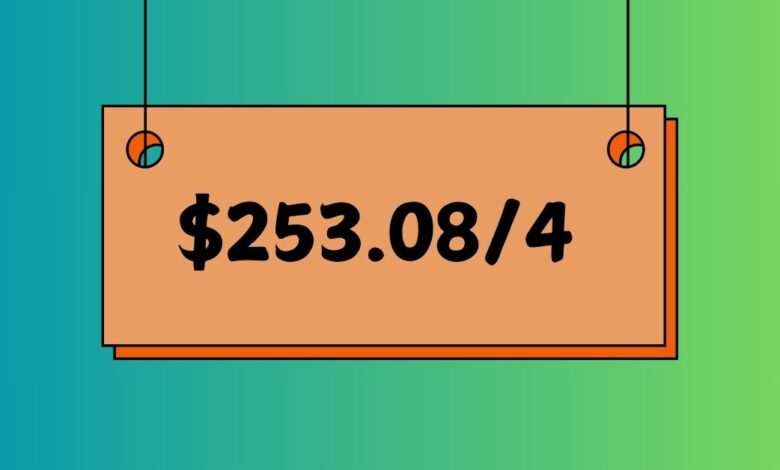$253.08/4: How to Manage and Simplify Financial Calculations

Understanding how to handle financial numbers efficiently can significantly simplify daily budgeting, expense sharing, and financial planning. One such common calculation that many people come across is $253.08 divided by four ($253.08/4). While this may seem like a simple mathematical division, the implications of this figure apply to various real-world financial scenarios. In this article, we’ll explore how to apply $253.08/4 in personal budgeting, splitting bills, managing installment payments, and more. Let’s dive into the practical uses of this value and how understanding such calculations can help streamline your finances.
The Basics: What Does $253.08/4 Mean?
At its core, $253.08/4 represents the division of $253.08 into four equal parts. This is a common calculation used in numerous financial activities. By dividing $253.08 by four, you get:
$253.08 ÷ 4 = $63.27
This result of $63.27 per portion becomes particularly useful in scenarios where payments, bills, or shared expenses need to be divided equally among four individuals or time periods.
Splitting a Bill Among Friends
One of the most practical applications of $253.08/4 is when splitting a bill with friends or family members. If a group of four people goes out to eat, and the total cost of the meal is $253.08, you can easily divide the bill equally. Each person would be responsible for paying:
$63.27 per person
This ensures fairness in group outings and eliminates the hassle of calculating individual shares based on what each person consumed. It’s a straightforward way to handle shared expenses when everyone agrees to pay equally.
Dividing Large Purchases into Installments
Another common use for $253.08/4 is dividing large purchases into smaller, more manageable payments. If you’ve made a purchase totaling $253.08 and have the option to split the payment into four equal installments, each payment would be:
$63.27 per installment
This type of arrangement is frequently seen in financing options for expensive products, such as electronics, appliances, or even vacation packages. By dividing the total cost into smaller installments, buyers can spread out the expense over time, making it easier to fit into their monthly budgets.
Quarterly Payments: Breaking Down Annual Expenses
For businesses and individuals alike, many services or subscriptions require quarterly payments. For instance, if you are billed $253.08 annually for a subscription, and the payment plan allows for quarterly installments, you would pay:
$63.27 every three months
This method of breaking down annual expenses into smaller quarterly payments can ease the financial burden and help with cash flow management. Many organizations offer this option to make their services more accessible and affordable over time.
Personal Budgeting: Making Expenses More Manageable
Dividing expenses like $253.08/4 can help with personal budgeting. If you have a total expense of $253.08 and want to spread the cost over four weeks, you would need to set aside:
$63.27 per week
This strategy is particularly useful for individuals who receive a weekly paycheck or prefer to break their monthly expenses into smaller chunks. By planning ahead and allocating $63.27 each week, you can manage your finances without feeling overwhelmed by a single large expense.
Shared Household Expenses
In shared living arrangements, whether between roommates or family members, it’s common to divide household expenses such as rent, utilities, and groceries. If the total monthly grocery bill comes to $253.08 and is to be divided among four people, each individual would contribute:
$63.27
This straightforward calculation helps avoid disagreements and ensures that everyone contributes their fair share to household expenses. It also makes budgeting for shared living arrangements easier by providing a clear and equal division of costs.
Budgeting for Vacations or Group Trips
When planning a vacation or group trip with friends or family, shared expenses like accommodations, meals, and transportation can add up quickly. If the total cost of accommodations for a trip is $253.08, and there are four travelers, dividing the expense would mean each traveler pays:
$63.27
This ensures that the financial responsibility is shared evenly among all participants, preventing potential conflicts or misunderstandings. Splitting travel expenses can also help keep the trip within budget for all members of the group.
Dividing a Gift or Donation
If you and three others want to contribute equally to a group gift or donation totaling $253.08, each person would need to contribute:
$63.27
This type of calculation makes it simple to divide a total amount into equal contributions, ensuring fairness and transparency in shared financial endeavors. Whether it’s for a wedding gift, charitable donation, or group investment, dividing the cost among participants is a common financial practice.
Quarterly Tax Payments for Freelancers
Freelancers and self-employed individuals often need to make quarterly estimated tax payments based on their income. If a freelancer owes $253.08 in taxes for the year, dividing this amount into quarterly payments would result in:
$63.27 per quarter
Making quarterly tax payments helps freelancers stay on top of their tax obligations and avoid large lump-sum payments at the end of the year. Breaking down tax payments into manageable portions is a critical strategy for maintaining financial stability as a freelancer.
Financial Planning and Forecasting
In financial planning, breaking down large sums into smaller, more manageable amounts helps create a clearer picture of upcoming expenses. If you know you’ll need $253.08 for an upcoming expense, and you want to save up over four months, you can set aside:
$63.27 per month
This method allows for more effective budgeting and saving strategies, ensuring that you can meet your financial goals without straining your monthly cash flow.
Mental Accounting: Why Breaking Down Costs Helps
Psychologically, breaking down a large expense into smaller portions, like $253.08/4, makes the amount seem more manageable. This concept is known as mental accounting, where individuals perceive smaller amounts to be easier to handle than larger lump sums. By dividing larger costs into smaller parts, people feel more in control of their finances, which reduces anxiety and helps them stick to their budgets more effectively.
Conclusion
The figure $253.08/4 may seem like a simple calculation, but its real-world applications are significant. Whether you’re splitting a bill with friends, dividing large purchases into installments, managing quarterly payments, or budgeting for a group trip, understanding how to break down expenses is an essential financial skill. By applying these principles, you can better manage your money, make informed financial decisions, and ensure fairness in shared financial responsibilities.
Learning how to effectively divide expenses can transform your approach to budgeting and financial planning. Whether it’s a shared meal, a quarterly tax payment, or a group vacation, knowing how to divide costs evenly helps reduce financial stress and promotes clearer communication among all parties involved.
FAQs
How does dividing expenses like $253.08/4 simplify budgeting?
Dividing expenses into smaller amounts makes them easier to manage, reducing the financial burden and making long-term planning more efficient.
What are some common scenarios where $253.08/4 is applicable?
This division is commonly used in bill-splitting, installment payments, quarterly business payments, and shared expenses in group settings.
How can breaking down expenses help with financial planning?
Dividing large expenses into smaller, periodic amounts allows for better budgeting, saving, and cash flow management, making long-term financial goals easier to achieve.
Why is mental accounting important in managing finances?
Mental accounting refers to the way people perceive smaller financial amounts as more manageable, which can make larger expenses feel less overwhelming when broken down into smaller parts.
Can this type of division apply to personal savings goals?
Yes, dividing a large savings goal into smaller monthly or weekly targets makes it easier to stay on track and meet financial objectives without feeling overwhelmed.



